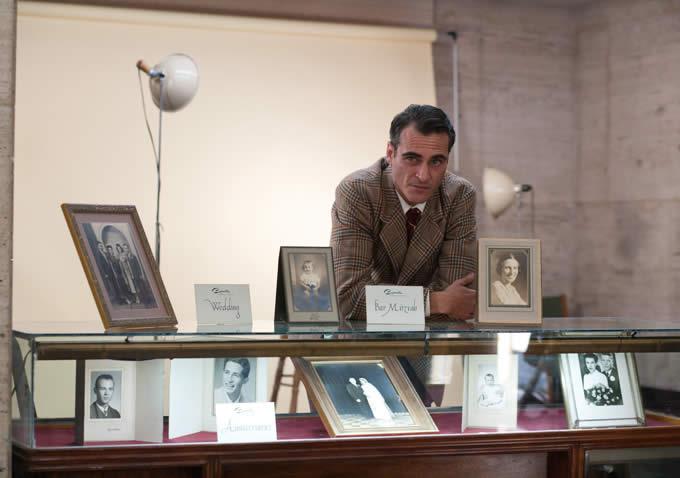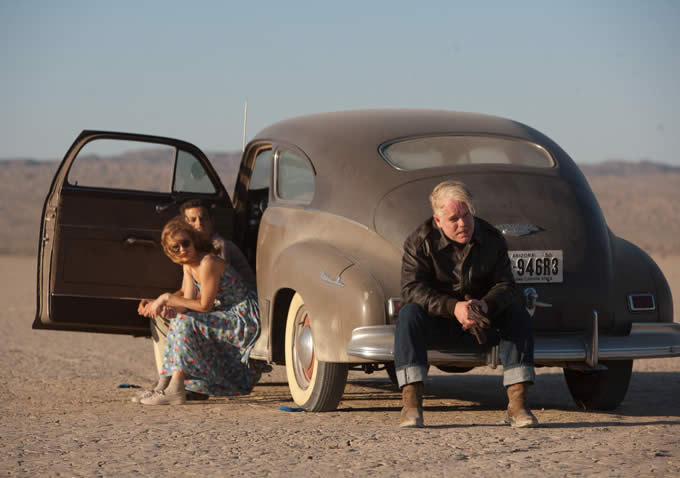 This ultimately unsatisfying film is a visual masterpiece with an extraordinary performance by Joaquin Phoenix. It’s also a brilliant depiction of alcoholism. But the story fizzles out like a spent Roman candle. With all of its achievements, it’s hard for me to imagine The Master pleasing more than the narrowest audience.
This ultimately unsatisfying film is a visual masterpiece with an extraordinary performance by Joaquin Phoenix. It’s also a brilliant depiction of alcoholism. But the story fizzles out like a spent Roman candle. With all of its achievements, it’s hard for me to imagine The Master pleasing more than the narrowest audience.
The story is about an emotionally troubled WW II vet (Joaquin Phoenix) who drifts through post-war America, leaving social carnage in his wake. His only success is in making moonshine out of available ingredients ranging from torpedo fuel to paint thinner. He happens upon the charismatic and manipulative author of a new path for seekers (Philip Seymour Hoffman), and the two men forge a bond. The leader enjoys the drifter’s moonshine and, when he needs a thug, harnesses the younger man’s rage. The drifter finds someone who seems to care about him, who offers a place and a sense of belonging.
Phoenix’s performance as Freddie Quell is one of the best of the century. Phoenix took some risks with the physicality of the performance, employing a hunch and a scowl that could have been too much, but instead help create a flawless performance. Freddie can stand quietly at the back of a room filled with people and fidget just enough so you absolutely know that he’s trouble.
Freddie is a damaged soul who self-medicates with alcohol. Joaquin Phoenix’s portrayal of his compulsion to drink and the inevitably unhappy (and sometimes lethal) consequences makes for one of the best ever movie portraits of an alcoholic.
(Two scenes of Freddie’s experience at a military hospital for battle traumatized vets are lifted directly from the brilliant John Huston documentary Let There Be Light, which I have written about and which you can watch for free on-line.)
Philip Seymour Hoffman is superb as the charismatic charlatan. Amy Adams and the rest of the cast give uniformly excellent performances.
Every single shot has been carefully composed, framed and photographed in especially beautiful 65 mm. The story takes place in the early 1950s, and every period detail is perfect. You could use any 100 shots from this film and make one glorious coffee table book.
The Master has been perhaps the years most awaited movie for two reasons. First, the Philip Seymour Hoffman character is inspired by L. Ron Hubbard, the founder of controversial and ever litigious Scientology. But the movie is really the story of the young transient (Phoenix’s character), and the cult created by Hoffman’s character is merely the setting.
Second, it was written and directed by acclaimed filmmaker Paul Thomas Anderson (Hard Eight, Boogie Nights, Magnolia, Punch-Drunk Love, There Will Be Blood). Since the fun and accessible Boogie Nights, Anderson has been specializing in critically anointed films that are not that audience-friendly. This time, Anderson has done his best job of directing, but the movie fails because his screenplay peters out.
I would happily invest two hours and 17 minutes into a good story that looks this good and is about a character this compelling. In the first half of the movie, I was on the edge of my seat, wondering “What will Freddie do next and what will happen to him?”. Unfortunately, the last half of the film takes Freddie a few thousand miles with very little dramatic payoff. So, like a boat inexpertly tied to the dock, the movie drifts in and out and bangs against the pilings. This could have been a masterpiece, but you need a good story to make one of those.


2 thoughts on “The Master: a visual and acting masterpiece that fizzles out”